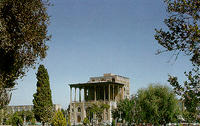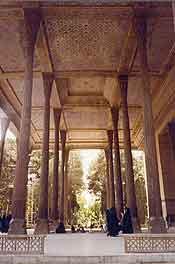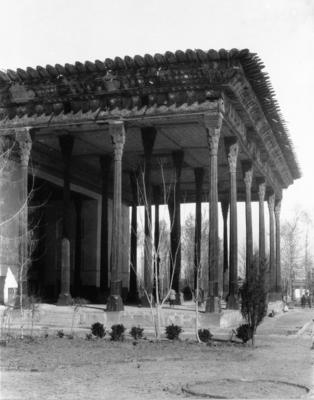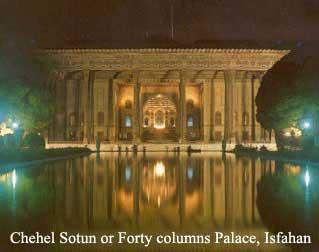Home of Oriental Plane Tree Part IV
 Chenar Wood
Chenar Wood
in Building
and Carpentry*
Plane (Chenar) wood is lightweight, hard (but easy to plane), with an attractive texture. It constitutes the main carpentry material in most non-wooded areas of the country, for instance in Isfahan, the farmers call it Mikh-e Tala-ee (golden peg) . Nowadays it is frequently used to make chests, doors, windows, parquet, veneer, etc.
 Above: Aali Ghapoo Palace
Above: Aali Ghapoo Palace
Adam Olearius, the member of the embassy sent by Duke of Holstein-Gottorp to the Safavid court in Isfahan during the first half of 17th (11th) century , when writing about Persian decorative woodwork, reports that Persians “like specially a kind of wood , unknown in Europe, called Tzinar (i.e., Chenar)….It is brown and has a wavy grain, and the Persian use it for doors and windows, which, when rubbed with oil, become incomparably finer than those made here (I.e. Europe) of walnut.”
Below: Chehel Sotun Palace
 The wooden columns in the former royal Safavid palaces Aali Ghapoo and Chehel Sotun in Isfahan (both built in first half of 11th century), are hewn out of plane logs to an average diameter of 60cm and still are holding firm in spite of severe insect damages.
The wooden columns in the former royal Safavid palaces Aali Ghapoo and Chehel Sotun in Isfahan (both built in first half of 11th century), are hewn out of plane logs to an average diameter of 60cm and still are holding firm in spite of severe insect damages.
Plane wood, usually obtained by pollarding the planes, is also used as fairly good fuel in some rural areas. (for individual presentation of plane in Persian painting, see Survey of Persian art XV, index, p.47, s.v. Plane trees)


Chenar Tree in Proverbs
For literary allusion to plane fire, in Dehkhoda dictionary we can read the proverb “ the plane fire is from the plane itself” and Farid-al-din Attar’s distich; “Every silkworm clothes itself with shroud, every plane tree ignites fire from itself.”
The statement by some Persian poet and lexicographers that “the plane is known to catch fire by itself” may have its explanation in flammability of dry plane wood: As in the primitive fire-making method of generating heat and then fire by the friction of two wooden objects, the dried spreading branches of an old plane rubbing together in the wind. Specially in dry weather may produce smoke or ignite fire from itself. Some of the above-mentioned “burnt planes” may have suffered from this phenomenon.

Fourty Colunm Palace has actually twenty columns. The name counts also their reflection in the pond.
*) Note:
The "Home of Oriental Plane Tree" parts, which comes with different titles, are taken from Encyclopaedia Iranica. The references and notes of original text are deleted, titles and subtitles are added to provide easy to read articles. For further study you can use http//www.Iranica.com --Siamak D. Ahi
Previous Parts:
Home of Oriental Plane Tree, Part I
http://chenarestan.blogspot.com/2005/07/home-of-oriental-plane-tree.html
Oriental Plane Tree and Healing, Part II
http://chenarestan.blogspot.com/2005/07/home-of-oriental-plane-tree-part-ii.html
Veneration of Old Trees, Part III
http://chenarestan.blogspot.com/2005/08/home-of-oriental-plane-tree-part-iii.html
 Chenar Wood
Chenar Wood in Building
and Carpentry*
Plane (Chenar) wood is lightweight, hard (but easy to plane), with an attractive texture. It constitutes the main carpentry material in most non-wooded areas of the country, for instance in Isfahan, the farmers call it Mikh-e Tala-ee (golden peg) . Nowadays it is frequently used to make chests, doors, windows, parquet, veneer, etc.
 Above: Aali Ghapoo Palace
Above: Aali Ghapoo PalaceAdam Olearius, the member of the embassy sent by Duke of Holstein-Gottorp to the Safavid court in Isfahan during the first half of 17th (11th) century , when writing about Persian decorative woodwork, reports that Persians “like specially a kind of wood , unknown in Europe, called Tzinar (i.e., Chenar)….It is brown and has a wavy grain, and the Persian use it for doors and windows, which, when rubbed with oil, become incomparably finer than those made here (I.e. Europe) of walnut.”
Below: Chehel Sotun Palace
 The wooden columns in the former royal Safavid palaces Aali Ghapoo and Chehel Sotun in Isfahan (both built in first half of 11th century), are hewn out of plane logs to an average diameter of 60cm and still are holding firm in spite of severe insect damages.
The wooden columns in the former royal Safavid palaces Aali Ghapoo and Chehel Sotun in Isfahan (both built in first half of 11th century), are hewn out of plane logs to an average diameter of 60cm and still are holding firm in spite of severe insect damages. Plane wood, usually obtained by pollarding the planes, is also used as fairly good fuel in some rural areas. (for individual presentation of plane in Persian painting, see Survey of Persian art XV, index, p.47, s.v. Plane trees)


Chenar Tree in Proverbs
For literary allusion to plane fire, in Dehkhoda dictionary we can read the proverb “ the plane fire is from the plane itself” and Farid-al-din Attar’s distich; “Every silkworm clothes itself with shroud, every plane tree ignites fire from itself.”
The statement by some Persian poet and lexicographers that “the plane is known to catch fire by itself” may have its explanation in flammability of dry plane wood: As in the primitive fire-making method of generating heat and then fire by the friction of two wooden objects, the dried spreading branches of an old plane rubbing together in the wind. Specially in dry weather may produce smoke or ignite fire from itself. Some of the above-mentioned “burnt planes” may have suffered from this phenomenon.

Fourty Colunm Palace has actually twenty columns. The name counts also their reflection in the pond.
*) Note:
The "Home of Oriental Plane Tree" parts, which comes with different titles, are taken from Encyclopaedia Iranica. The references and notes of original text are deleted, titles and subtitles are added to provide easy to read articles. For further study you can use http//www.Iranica.com --Siamak D. Ahi
Previous Parts:
Home of Oriental Plane Tree, Part I
http://chenarestan.blogspot.com/2005/07/home-of-oriental-plane-tree.html
Oriental Plane Tree and Healing, Part II
http://chenarestan.blogspot.com/2005/07/home-of-oriental-plane-tree-part-ii.html
Veneration of Old Trees, Part III
http://chenarestan.blogspot.com/2005/08/home-of-oriental-plane-tree-part-iii.html

5 Comments:
This comment has been removed by a blog administrator.
By Anonymous, at 2:56 PM
Anonymous, at 2:56 PM
louis vuitton outlet, louis vuitton outlet, longchamp outlet, christian louboutin outlet, ugg boots, tiffany and co, ray ban sunglasses, tory burch outlet, longchamp outlet, burberry pas cher, michael kors pas cher, chanel handbags, air max, christian louboutin shoes, oakley sunglasses, ray ban sunglasses, oakley sunglasses wholesale, sac longchamp pas cher, nike air max, jordan shoes, christian louboutin, louis vuitton, cheap oakley sunglasses, ray ban sunglasses, ugg boots, nike outlet, prada outlet, oakley sunglasses, prada handbags, louboutin pas cher, tiffany jewelry, nike air max, replica watches, polo outlet, nike roshe, louis vuitton, nike free run, gucci handbags, kate spade outlet, louis vuitton outlet, longchamp pas cher, oakley sunglasses, christian louboutin uk, polo ralph lauren outlet online, jordan pas cher, nike free, uggs on sale, polo ralph lauren, replica watches
By oakleyses, at 6:35 PM
oakleyses, at 6:35 PM
new balance shoes, converse, baseball bats, ray ban, ferragamo shoes, vans outlet, babyliss, hermes belt, converse outlet, p90x workout, instyler, louboutin, mac cosmetics, lancel, jimmy choo outlet, mont blanc pens, wedding dresses, valentino shoes, celine handbags, ghd hair, vans, nike air max, hollister, bottega veneta, ralph lauren, north face outlet, lululemon, north face outlet, nfl jerseys, oakley, insanity workout, iphone cases, chi flat iron, gucci, mcm handbags, soccer shoes, abercrombie and fitch, nike roshe run, asics running shoes, soccer jerseys, hollister clothing, reebok outlet, hollister, beats by dre, herve leger, nike huaraches, timberland boots, longchamp uk, nike trainers uk, nike air max
By oakleyses, at 6:38 PM
oakleyses, at 6:38 PM
ugg, moncler, montre pas cher, moncler, louis vuitton, louis vuitton, thomas sabo, links of london, canada goose, doudoune moncler, marc jacobs, pandora uk, pandora jewelry, louis vuitton, ugg pas cher, canada goose jackets, pandora jewelry, canada goose outlet, replica watches, canada goose outlet, swarovski, pandora charms, moncler uk, moncler, karen millen uk, ugg,uggs,uggs canada, moncler, canada goose, wedding dresses, ugg uk, juicy couture outlet, supra shoes, moncler outlet, juicy couture outlet, swarovski crystal, ugg,ugg australia,ugg italia, hollister, canada goose outlet, moncler outlet, louis vuitton, canada goose uk, coach outlet, toms shoes, louis vuitton, canada goose
By oakleyses, at 6:40 PM
oakleyses, at 6:40 PM
I love the podcasts available on this site.
By خبير الأشعة التداخلية, at 5:36 AM
خبير الأشعة التداخلية, at 5:36 AM
Post a Comment
<< Home